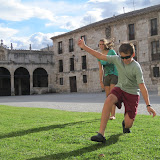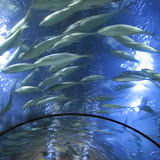Morocco was gorgeous, fascinating and challenging. There is poverty that hits you hard and makes you realize that you are one of the lucky ones, one of the ones assured of enough food and a bed to sleep on every night. Yet there is a large middle class with a high level of education whose members have chosen to live in Morocco because they prefer it there. We were lucky to be hosted by friends whom we had met when they came to New England last May on a student exchange – in fact, we had a ready-made community waiting for us. This made our travel so much easier and more educational. Trips to Rabat, Casablanca and Mohammedia on the Atlantic coast were sandwiched between evenings discussing politics, eating incredibly good local food and learning about Moroccan history and culture.
Some memories that come to mind when I think of Morocco:
 · The Hassan II Mosque in Casablanca, with millions of tiny tiles all handmade, inlaid into gorgeous mosaic walls. On the lower level are 42 enormous and intricately designed fountains where 800 worshippers can cleanse their hands, face and feet at the same time in preparation for prayers.
· The Hassan II Mosque in Casablanca, with millions of tiny tiles all handmade, inlaid into gorgeous mosaic walls. On the lower level are 42 enormous and intricately designed fountains where 800 worshippers can cleanse their hands, face and feet at the same time in preparation for prayers.
· The Jma el Fna Square in Marrakesh, with smoke rising from hundreds of kitchens in the center that offer tajine, kebabs, and couscous every night. With the buildings lit up around the huge square, one has the impression of an enormous party for thousands,. However around the edges, mothers send their young children to ask the tourists for spare change.
· Sleeping in a riad, a traditional home/hotel in the old quarter on our first night in Tangiers, I listened to a continual soundtrack all night long. Buyers and sellers, horse-drawn wagons pulling produce, young people partying, dogs barking and babies crying. Then early in the morning when I awoke I looked out the window to see the street sellers setting up their wares for the new day and others, not as lucky as we, arising out of their simple tents set up on the roof of the market, greeting the day.
· At dusk, following a middle aged man on a motorcycle as he wove among pedestrians, animals, cars and trucks, leading our car on a labyrinthine trail through the medina in Marrakesh, helping us find the parking lot as he had promised. He had to stop and wait for us numerous times as we were not as bold as he. Once we had to jam on our brakes as we came through a tunneled wall around a corner and found two young bicyclists speeding almost into our car.
 · Visiting Chellah outside Rabat, the old Roman and Phoenician city, now abandoned, with vines, Roman columns, stray cats and 15th century pools and aqueducts among the ruins. It reminded me of pictures I’ve seen of Angkor Wat in Cambodia, so regal and melancholy.
· Visiting Chellah outside Rabat, the old Roman and Phoenician city, now abandoned, with vines, Roman columns, stray cats and 15th century pools and aqueducts among the ruins. It reminded me of pictures I’ve seen of Angkor Wat in Cambodia, so regal and melancholy.
· Hiking in the High Atlas Mountains along a mountain path, with nothing around us but sheep herders, snow-capped peaks, and villages down below, made entirely of stone and adobe. Shy travelers passed us by on the narrow paths, leading their donkeys carrying loads of vegetables from their terraced gardens or stone for construction.
· Spending a wonderful quiet night in the olive orchard belonging to a friend of a friend, outside Marrakesh. They have worked for several years, adding sleeping and eating quarters to a very simple “terrain” or farm. They started with a lovely swimming pool which is shared with the neighbors. Then they added a simple outdoors kitchen, a dining and living area with fireplace for cold nights, several tents and cottages, and a bathroom building. Though simple, everything one would need is provided, in a sense of generous Moroccan hospitality.
· Listening to the muezzin, the calls to prayer from each mosque, that sound five times per day. The prayer starts with a sonorous male voice singing “Allah Akbar” and continues for several minutes. In Marrakesh, our riad was within earshot of 5 or 6 different mosques. The calls were staggered, with some ending after others had started up, so the sound went on for a good 15 minutes. Someone told me that it is a call to prayer, but it is actually a prayer being sung as well. Hearing a prayer being sung through the city at 5 in the morning is a wonderful way to wake up.
Despite our friends helping us to understand much about Morocco, we found so many mysteries, things that seemed very foreign to us. First, the absence of road signs in the medinas makes it just about impossible to find anything. We used the good maps in the Lonely Planet and DK guides, but we wished we had brought a compass along.We ended up hiring people to lead us places, either by car or on foot. With a large number of people who are unemployed, tourists get frequent offers to help find places.
 In the cities, the mixture of different peoples with their own clothing style was a mystery to us. Some men wear a long dark blue robe with attached hood, pointed at the top. Male water sellers wear huge pointed multicolored hats, looking like tourists just back from Mexico, with matching multicolored short skirts and tunics. They clang their metal cups and offer water to passersby. Women choose many different levels of veiling, from none to a covering leaving only a slit for the eyes. We saw an old woman who sits all day at the tomb of a 17th century saint in Casablanca. She seemed to be worshiping the saint, not collecting tips. Why was she there all day?
In the cities, the mixture of different peoples with their own clothing style was a mystery to us. Some men wear a long dark blue robe with attached hood, pointed at the top. Male water sellers wear huge pointed multicolored hats, looking like tourists just back from Mexico, with matching multicolored short skirts and tunics. They clang their metal cups and offer water to passersby. Women choose many different levels of veiling, from none to a covering leaving only a slit for the eyes. We saw an old woman who sits all day at the tomb of a 17th century saint in Casablanca. She seemed to be worshiping the saint, not collecting tips. Why was she there all day?
 When we traveled in the medinas, several people said to us that visitors must not go to certain areas, that they are closed to foreigners. Others said this is nonsense, that there are no closed areas. Which is true? And how can this job be acceptable work for anyone? These men are wading in camel and pigeon urine, processing hides to produce leather belts and purses for tourists.
When we traveled in the medinas, several people said to us that visitors must not go to certain areas, that they are closed to foreigners. Others said this is nonsense, that there are no closed areas. Which is true? And how can this job be acceptable work for anyone? These men are wading in camel and pigeon urine, processing hides to produce leather belts and purses for tourists.
Another mystery to us was the negotiation, or "marchandise", that has to be done to purchase almost anything. It is disorienting not to know even the ceiling nor the floor price when looking at an item. There is no such thing as idly looking at a price tag. Asking the merchant how much they want for something changes your status to an active participant in the buying game. Once you have requested a price, you are often invited to sit in the back room drinking mint tea, to discuss exactly what you are looking for and to wait while the most desired product is brought from downstairs, or across town for that matter, for your inspection. It is hard to disengage from this situation without having bought something.
Here are some recommendations I would have for those who visit Morocco:
 In Fez, ask for Abdul Larbi Moumen who offers guided tours and Arabic language. He seemed a very well informed and gentle soul who would be an excellent teacher. His phone is 067 324 5542.
In Fez, ask for Abdul Larbi Moumen who offers guided tours and Arabic language. He seemed a very well informed and gentle soul who would be an excellent teacher. His phone is 067 324 5542.
In the High Atlas Mountains, we were so lucky to visit a village called Tizi n’Oucheg for the night and to go on a hike from there. Rachid Mandili (mandili.rachid@gmail.com) offers his home and his family cooks wonderful meals for trekkers. Our friends have helped Rachid and his village by teaching them how to make and market jams, which is becoming a successful microenterprise. Now they offer nut butters and fig and blackberry jam with breakfast for tourists. Laure, one of our friends who teaches in Mohammedia, has taken her students to the village where they have helped the local Berber people with the jam project and others as well.
We found that renting a car was worthwhile for the 5 of us, though it was an item of continual discussion given the challenging roads. It is inadvisable to drive on the highway after dark, since many pedestrians cross the road or walk along it and there is very little lighting outside the cities. However the car gave our family of 5 flexibility and was able to fit us somewhat more comfortably than we would have been in a “grand taxi” that seats 4. We found that our car could actually fit up to 8!
 We stayed in two great riads: Riad Tanja in Tangiers and Riad Jnane Mogador in Marrakesh. A wonderful restaurant we went to was La Sqala in Casablanca. It was a historic fortress, part of the old wall, that was turned into a restaurant. The food was fabulous, with long trays for tasting 15 different delicacies among the dishes.
We stayed in two great riads: Riad Tanja in Tangiers and Riad Jnane Mogador in Marrakesh. A wonderful restaurant we went to was La Sqala in Casablanca. It was a historic fortress, part of the old wall, that was turned into a restaurant. The food was fabulous, with long trays for tasting 15 different delicacies among the dishes.
Hammam:
Even before we got to Morocco, I was looking forward to taking a ritual bath, or hammam. In every medina, or old city, there are many hammams, generally with signs posting separate times each day for men's and for women's usage. In the past, hammams were used for keeping clean and for socializing. Now, however, most homes have hot water, but the hammam continues to play an important role in the community.
The hammam included a steam room and cleansing, followed by a massage. We first had buckets of warm water poured over us, then we soaped up with a mysterious black squishy soap. Then the attendant scrubbed us with a stiff cloth to take the dead skin off (yuck!) After more water and resting in the steam bath, we had a wonderful relaxing massage. Mmmmm.
Next, back to Spain to see what the Europeans have been able to make of it after the Moorish kingdom ended in 1492....



















